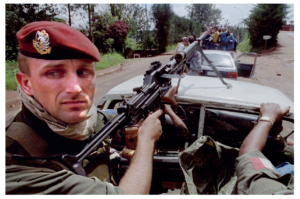Source R A French soldier escorts a convoy of Europeans to the airport in Kigali for
evacuation (12 April 1994).

Question
18. With reference to its origin, purpose and content, analyse the value and limitations of
Source Q for an historian investigating the assassination of Habyarimana. [4]
▶️Answer/Explanation
Ans
18. Value:
•Keane may have based his book on contemporary accounts of the assassination as he was in Rwanda in 1994.
•As an award-winning journalist, writing after the conflict, he may have been able to give a more objective view on the impact of the assassination and/or may have benefitted from a degree of hindsight.
•The content seems to attempt to offer a balanced account of the assassination and suggests various theories.
Limitations:
•Keane‘s account may have been influenced by his personal experience of the genocide.
•He may not have had access to Rwandan or French government sources by the time the book was published in 1996.
•The vivid title of the book, Season of Blood, and the tone of the content, suggest that the book is aimed at a popular audience and the language used is emotive and may tend to journalistic exaggeration.
The focus of the question is on the value and limitations of the question. If only value or limitations are discussed, award a maximum of [2]. Origins, purpose and content should be used as supporting evidence to make relevant comments on the values and limitations. For [4] there must be at least one reference to each of them in either the values or the limitations.
Source S Timothy Longman, a professor of African Studies, writing in the essay “An
overview of the Rwandan Genocide”, in the book for students Perspectives on
Modern World History. The Rwandan Genocide (2010).
The assassination of Habyarimana was the spark that set the plans for genocide in motion. Within hours
of the crash, members of the presidential guard and other elite troops—carrying hit lists composed of
the names of persons perceived to be RPF sympathizers, including prominent Tutsi and Hutu opposition
politicians and civil society activists—were spreading throughout the capital. On April 7 [1994], the
presidential guard assassinated the Prime Minister Agathe Uwilingiyimana, a moderate Hutu, along with
ten Belgian UN troops who had been guarding her. On the first day of the genocide, death squads also
killed several cabinet ministers, justices of the constitutional court, journalists, human rights activists and
progressive priests. For several days, the murderous attacks took place primarily in Kigali and were
focused on prominent individuals, both Hutu and Tutsi, perceived to be opponents of the regime. The
international community at this initial stage of the genocide, construed the violence in Rwanda as an
ethnic uprising, a spontaneous popular reaction to the death of the president.
Question
19. Compare and contrast what Sources S and T reveal about the events that followed the assassination of Habyarimana in 1994. [6]
▶️Answer/Explanation
Ans.
19. Comparisons:
•Both suggest that Habyarimana’s death led to violence.
•Both suggest that the attacks were pre-planned and/or both suggest “lists” had been drawn up and were used to target individuals.
•Both suggest that UN peacekeepers had tried to protect the prime minister, and that the Belgian peacekeepers had been killed.
Contrasts:
•Source T suggests that Dallaire understood that the violence was targeted whereas Source S suggests that the international community initially construed the violence as a spontaneous popular reaction to the death of the president.
•Source S suggests that, initially, the attacks were mainly limited to Kigali whereas Source T suggests that from 7 April there were attacks on all Rwandan Tutsis.
•Source S focuses only on the attacks by Hutu extremists and/or groups whereas Source T suggests that the RPF responded to the initial violence by renewing the civil.
